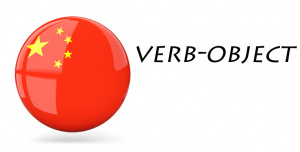Difference between revisions of "Language/Mandarin-chinese/Grammar/Separable-verbs"
| Line 68: | Line 68: | ||
In dictionaries, a combination of a separable verb and an object are noted with “//” between their pinyin. | In dictionaries, a combination of a separable verb and an object are noted with “//” between their pinyin. | ||
== | ==Some Common Separable Verbs== | ||
{| class="wikitable" | {| class="wikitable" | ||
| Line 75: | Line 75: | ||
!Translation | !Translation | ||
|- | |- | ||
|<span class="notranslate">上课</span> | |<span class="notranslate">上課/上课</span> | ||
|shàng//kè | |shàng//kè | ||
|to have a class | |to have a class | ||
| Line 83: | Line 83: | ||
|to be hospitalised | |to be hospitalised | ||
|- | |- | ||
|<span class="notranslate">发烧</span> | |<span class="notranslate">發燒/发烧</span> | ||
|fā//shāo | |fā//shāo | ||
|to get a fever | |to get a fever | ||
|- | |- | ||
|<span class="notranslate">吃饭</span> | |<span class="notranslate">吃飯/吃饭</span> | ||
|chī//fàn | |chī//fàn | ||
|to eat | |to eat | ||
|- | |- | ||
|<span class="notranslate">开学</span> | |<span class="notranslate">開學/开学</span> | ||
|kāi//xué | |kāi//xué | ||
|to start a new term of school | |to start a new term of school | ||
|- | |- | ||
|<span class="notranslate">开车</span> | |<span class="notranslate">開車/开车</span> | ||
|kāi//chē | |kāi//chē | ||
|to drive | |to drive | ||
| Line 111: | Line 111: | ||
|to see a doctor | |to see a doctor | ||
|- | |- | ||
|<span class="notranslate">睡觉</span> | |<span class="notranslate">睡覺/睡觉</span> | ||
|shuì//jiào | |shuì//jiào | ||
|to sleep | |to sleep | ||
| Line 119: | Line 119: | ||
|to chat | |to chat | ||
|- | |- | ||
|<span class="notranslate">说话</span> | |<span class="notranslate">說話/说话</span> | ||
|shuō//huà | |shuō//huà | ||
|to speak | |to speak | ||
Revision as of 15:22, 17 November 2018
Hello everybody!
In today's lesson, we will teach you how to use certain kinds of verbs that still need a complement.
“Separable words”(离合詞/离合词, líhécí) or “separable verbs”(离合動詞/离合动词, líhédòngcí) get their name from their ability to "separate" into two parts (mainly a verb part and an object part), with other words in between. In fact, you could also simply call separable verbs "verb-object phrases". Some linguistics consider a “verb-object phrase” as two words, the other consider it as a phrase.
Feel free to edit this wiki page, if you think it can be improved.
Object verbs
If the verb 說/说 (shuō) "to speak" is followed by a complement, it is used alone:
- 我說漢語。/我说汉语。 (Wǒ shuō hànyǔ.)
I speak Chinese.
But if we simply mean “talk”, we must add a “standard complement”: 話/话 (huà).
To say “He speaks”, we have to use 他說話。/他说话。 (Tā shuō huà.) and not simply 他說。/他说。 (Tā shuō.).
We also have already seen “write” 寫/写 (xiě) which requires the standard complement 字 (zì):
- 她寫字。/她写字。 (Tā xiě zì.)
She writes.
Attention, it is absolutely necessary to remove the standard complement when another complement is specified.
The following sentence is therefore false: 他說話漢語/他说话汉语。 (Tā shuō huà hànyǔ.)
A verb-object may be heard alone, but in this case the complement is implied:
- (漢語)我會說,不會寫。/(汉语)我会说,不会写。 [(Hànyǔ) wǒ huì shuō, bú huì xiě]
(Chinese) I can speak it, but not write it.
As is said, there can be other words in between of the verb and the object. Let's see how it works:
Words can be added between a separable verb and an object are:
- 了 (le);
- 著/着 (zhe);
- 過/过 (guò);
- 不 (bù);
- 得 (de);
- result complement (e.g. 好, 起);
- classifier (e.g. 個/个, 節/节).
Separable words can be classified into three categories:
- predicative and object, e.g. 上課/上课, 開車/开车, only 了, 著/着, 過/过, result complement, classifier, combination of 了 and classifier, combination of 著/着 and classifier (rare) can be inserted, leaving alone attributes of the object;
- verb and result complement, e.g. 看見/看见, 撥動/拨动, only 不, 得 can be inserted;
- verb and directional verb, e.g. 出來/出来, 分開/分开, only 不, 得, can be inserted.
- 我上了節課。/我上了节课。 (Wǒ shàng le jié kè.)
I went to class.
- 我上了節有趣的課。/我上了节有趣的课。 (Wǒ shàng le jié yǒuqùde kè.)
I went to an interesting class.
- 我開起車來。/我开起车来。 (Wǒ kāi qǐ chē lái.)
I started driving.
- 我看得見。/我看得见。 (Wǒ kàn de jiàn.)
I can see it.
- 我出不來。/我出不来。 (Wǒ chū bù lái.)
I can't get out.
In dictionaries, a combination of a separable verb and an object are noted with “//” between their pinyin.
Some Common Separable Verbs
| Chinese | Pinyin (dictionary form) | Translation |
|---|---|---|
| 上課/上课 | shàng//kè | to have a class |
| 住院 | zhù//yuàn | to be hospitalised |
| 發燒/发烧 | fā//shāo | to get a fever |
| 吃飯/吃饭 | chī//fàn | to eat |
| 開學/开学 | kāi//xué | to start a new term of school |
| 開車/开车 | kāi//chē | to drive |
| 打的 | dǎ//dī | to get a taxi |
| 游泳 | yóu//yǒng | to swim |
| 看病 | kàn//bìng | to see a doctor |
| 睡覺/睡觉 | shuì//jiào | to sleep |
| 聊天 | liáo//tiān | to chat |
| 說話/说话 | shuō//huà | to speak |
| 起床 | qǐ//chuáng | to get up |
Sources
https://resources.allsetlearning.com/chinese/grammar/Separable_verb
http://www.chine-culture.com/chinois/cours-de-chinois-6-grammaire.php
